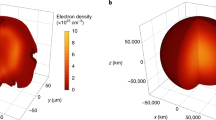Abstract
TRANSITIONS from a diffuse to a concentrated positive column have been observed to occur in electrical discharges in hydrogen as the current is increased1, and a similar transition occurs from the ‘low-current’ to the ‘high-current’ carbon arc in air2a,d. As a result of a wide investigation of arcs in these and other gases, a purely thermal theory of these transitions has been developed, in contrast to the suggested explanation based on the magnetic pinch effect2a,3. A development and numerical integration of the equation of energy balance for the positive column of the arc after the manner of Brinkman4 has enabled the radial temperature distribution for different central temperatures, and the variation of central temperature with current, to be calculated. In this the characteristic relationship between the temperature and the thermal conductivity, including the contributions of the classical kinetic theory and of the diffusion of ionized and dissociated pairs, which has been studied by a number of authors2b,4–6 is of paramount importance. The data for nitrogen are illustrated in Fig. 1. The two maxima of the thermal conductivity at about 7,000° K. and 14,000° K. result from the dissociation and ionization of the gas respectively. In diatomic gases, the ‘low-current’ arc exists with central temperatures corresponding to the positive slope to the first maximum of the thermal conductivity–temperature curve, and the development of the concentrated core of the ‘high-current’ arc occurs in the region of negative slope, that is, between 7,000° and 9,000° K., for the arc in air or nitrogen.
This is a preview of subscription content, access via your institution
Access options
Subscribe to this journal
Receive 51 print issues and online access
$199.00 per year
only $3.90 per issue
Buy this article
- Purchase on Springer Link
- Instant access to full article PDF
Prices may be subject to local taxes which are calculated during checkout
Similar content being viewed by others
References
Bruce, C. E. R., Nature, 161, 521 (1948).
Finkelnburg, W., Fiat Report No. 1052, (a) p. 5; (b) p. 123; (c) p. 96; (d) Amer. Inst. Elect. Eng. Trans., 70, 800 (1951).
Bassett, P. R., Illum. Eng. Soc. Trans., 27, 621 (1932).
Brinkman, H., thesis, Utrecht, 1937, p. 76.
ter Horst, thesis, Utrecht, 1934, p. 134.
Höcker and Schulz, Naturforschung, 49 (4), 266 (1949).
Gaydon, A. G., Nature, 153, 407 (1944).
Maecker, H., Z. Phys., 136, 119 (1953).
Ornstein, L. S., K. Akad. v. Wet. Amsterdam, 40 (1931).
Author information
Authors and Affiliations
Rights and permissions
About this article
Cite this article
KING, L. The Positive Column of High- and Low- Current Arcs. Nature 174, 1008–1009 (1954). https://doi.org/10.1038/1741008a0
Issue Date:
DOI: https://doi.org/10.1038/1741008a0
This article is cited by
-
Berechnung und Messung der W�rmeleitf�higkeit von Stickstoff bis 13000� K
Zeitschrift f�r Physik (1959)
-
Eine Theorie des Wechselstromkreises mit Lichtbogen
Archiv für Elektrotechnik (1959)
-
Über das Auftreten von Dampfstrahlen in Kohlelichtbögen hoher Stromstärken. I
Zeitschrift für Physik A Hadrons and nuclei (1958)
-
Formation of the High-Pressure Arc Column in Hydrogen
Nature (1956)
-
�ber eine experimentelle und theoretische Bestimmung der W�rmeleitf�higkeit des Plasmas eines Hochstromkohlebogens
Zeitschrift f�r Physik (1956)
Comments
By submitting a comment you agree to abide by our Terms and Community Guidelines. If you find something abusive or that does not comply with our terms or guidelines please flag it as inappropriate.



